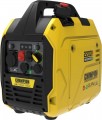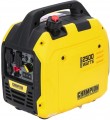Fuel
The type of fuel that the generator's engine runs on.
—
Gasoline. One of the main types of fuel for internal combustion engines. Gasoline generators are usually cheaper than diesel generators, all other things being equal, but they are more expensive to run due to the higher price of gasoline; in addition, they usually have a shorter resource than diesel ones. Therefore, it is believed that gasoline generators are well suited primarily as a backup power source in case of a power outage.
—
Diesel. Diesel generators are usually more expensive than their gasoline counterparts; on the other hand, diesel fuel is cheaper than gasoline, so the increased cost may well pay off with regular use. In addition, diesel generators have a longer resource and a larger power range than gasoline ones. This allows them to be used as both backup and main power sources, including at rather "energy-intensive" objects.
—
Gas. The advantages of gas-fired generators are relatively low noise levels and low emissions. On the other hand, the use of gas as a fuel is associated with certain difficulties: it is necessary to connect to a gas pipeline or regularly replace special cylinders, the fuel system is especially sensitive to leaks, etc. Therefore, there are relatively few such models produced, and most of them are stationary high power generators, in which the mentioned disa
...dvantages are covered by the advantages.
- Gasoline / gas. Models capable of using both types of fuel indicated. This gives the user the opportunity to choose the option that best suits a particular situation, and also reduces the likelihood of being left without fuel at the most inopportune moment; on the other hand, such models are more expensive than single-fuel ones. The technical features of gasoline and gas are described in detail above.Max. power
The maximum power output that the generator can provide.
This power is slightly higher than the nominal (see above), but the maximum performance mode can only be maintained for a very short time - otherwise an overload occurs. Therefore, the practical meaning of this characteristic is mainly to describe the efficiency of the generator when working with increased starting currents.
Let us recall that some types of electrical appliances consume several times more power (and, accordingly, power) at the moment of starting than in the normal mode; this is typical mainly for devices with electric motors, such as power tools, refrigerators, etc. However, increased power for such equipment is needed only for a short time, normal operation is restored in literally a few seconds. And you can estimate the starting characteristics by multiplying the nominal power by the so-called starting coefficient. For equipment of the same type, it is more or less the same (1.2 - 1.3 for most power tools, 2 for a microwave oven, 3.5 for an air conditioner, etc.); more detailed data is available in special sources.
Ideally, the maximum power of the generator should be no less than the total peak power of the connected load - that is, the starting power of equipment with a starting factor greater than 1 plus the rated power of all other equipment. This will minimize the likelihood of overloads.
Motor type
Model name of the engine installed in the generator. Knowing this name, you can, if necessary, find detailed data on the engine and clarify how it meets your requirements. In addition, model data may be needed for some specific tasks, including maintenance and repair.
Note that modern generators are often equipped with
branded engines from famous manufacturers: Honda, John Deere, Mitsubishi, Volvo, etc. Such engines are more expensive than similar units from little-known brands, but this is offset by higher quality and/or solid warranty conditions , and in many cases, the ease of finding spare parts and additional documentation (such as manuals for special maintenance and minor repairs).
Power
The operating power of the engine installed in the generator. Traditionally stated in horsepower; 1 HP approximately equal to 735 watts.
First of all, the rated power of the generator directly depends on this indicator (see above): in principle, it cannot be higher than the engine power, moreover, part of the engine power is spent on heat, friction and other losses. And the smaller the difference between these capacities, the higher the efficiency of the generator and the more economical it is. However high efficiency affects the cost, but this difference can pay off with regular use due to fuel savings.
Fuel consumption (100% load)
The amount of fuel consumed by the generator when operating at full power. The parameter is specified for petrol and diesel units (and for models on combined fuel - when using petrol).
In full power mode, the generator consumes maximum fuel. However, such long-term operation is fraught with accelerated wear of the unit components, so generators are rarely loaded to 100%. Nevertheless, the parameter gives an approximate understanding of the expected fuel consumption when used "at full capacity".
Total number of sockets
The total number of sockets for 230 and/or 400 V provided in the design of the generator.
This number corresponds to the number of devices that can be simultaneously connected to the generator without using splitters, extension cords, etc. If it is a three-phase model (see "Output voltage") with different types of sockets, it is worth specifying the quantity of each type separately, as different models may have varying configurations. For example, a unit specified as having
3 sockets might have 1 three-phase socket and 2 single-phase ones, or 2 three-phase and 1 single-phase socket. Generally, the most basic modern generators have only
1 socket, though models with
2 sockets are more common; and the most powerful models can have
4 or more sockets.
It is also important to remember that the ability to connect various devices is limited not only by the number of sockets but also by the generator's rated power (see above for more details).
Sockets 230 V
The number of 230 V sockets provided in the design of the generator, as well as the type of connectors used in such sockets.
The type of connector in this case is indicated by the maximum power that is allowed for the outlet - for example, “2 pieces for 16 A”. The most popular options for 230-volt outlets are
16 A,
32 A, and 63 A. We emphasize that amperes in this designation are not the actual power that the generator can produce, but the outlet’s own limitation; the actual power value is usually noticeably lower. Simply put, if, for example, the generator has a 32 A socket, the output power on it will not reach 32 A; and the specific number of amperes will depend on the rated and maximum power of the unit (see above). So, if for our example we take a rated power of 5 kW and a maximum of 6 kW, then to a 230 V outlet such a generator will be able to produce no more than 5 kW / 230 V = 22.7 A standard and 6 kW / 230 V = 27, 3 A at its peak. And if the power has to be divided between several outlets, then it will accordingly be even less.
As for specific types of connectors, the higher the power permissible for the outlet, the higher the requirements for its reliability and quality of protection. In light of this, as a rule, higher power outlets can be connected to lower power plugs (directly or through an adapter), but not vice versa. And if there are several sockets, by their type it i
...s possible to estimate with some certainty the distribution of the entire power of the generator between them: between two identical sockets such power is usually divided equally, and more power is allocated to an socket with a larger number of amperes and power. However, specific details on this matter should be clarified separately in each case; It's also worth considering 400V outlets, if available (see below).USB charging port
The generator has
a USB connector(one or more) for charging various devices. Most modern smartphones and tablets can be charged from USB, and this charging method is also found in many other equipment - from cameras and flashlights to electric screwdrivers and radio-controlled models. The standard supply voltage through this connector is 5 V, but the power may be different, it should be specified separately.
Sound level (7 m)
Sound pressure level in decibels at a distance of 7 m between the noise source and the ear of the equipment operator. Since people do not work in the immediate vicinity of the generator, the parameter will be useful for estimating the noise level at a distance. For example, current European Union regulations require that the sound power of generating sets with a power of more than 2 kW does not exceed 97 dB — at a distance of 7 m, the noise from the generator engine will correspond to a sound pressure of about 72 dB.

